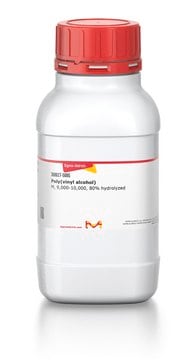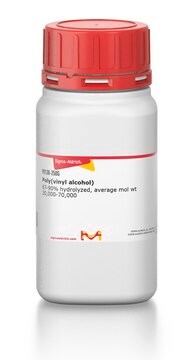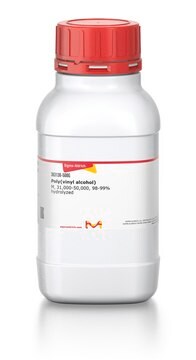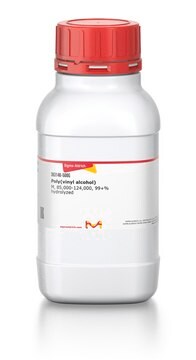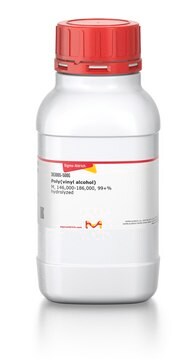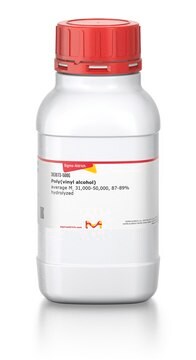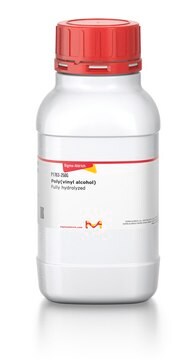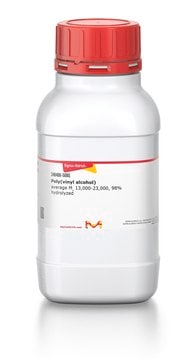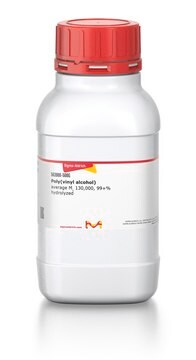363170
Poly(vinyl alcohol)
Mw 13,000-23,000, 87-89% hydrolyzed
Synonym(s):
PVA
Sign Into View Organizational & Contract Pricing
All Photos(2)
About This Item
Linear Formula:
[-CH2CHOH-]n
CAS Number:
MDL number:
UNSPSC Code:
12352104
NACRES:
NA.23
Recommended Products
form
crystalline powder
crystals or granules
powder
mol wt
Mw 13,000-23,000
falling ball
3.5-4.5 cP, 4 % in H2O(20 °C)(lit.)
InChI
1S/C2H4O/c1-2-3/h2-3H,1H2
InChI key
IMROMDMJAWUWLK-UHFFFAOYSA-N
Looking for similar products? Visit Product Comparison Guide
General description
Polyvinyl alcohol(PVA) is a linear hydrophilicsynthetic polymer with a monoclinic crystal structure. It can be synthesized via the polymerization of vinyl esters orethers, with subsequent saponification or transesterification. Due to itsexcellent physical and chemical properties, PVA has been widely used inadhesives, fibers, paper industry, drug delivery, and tissue engineering.
Application
PVA is used as a biological reagent to test the dispersion of zinc oxide nanoparticles. PVA has been evaluated as an effective protein resistant material.2 It may be used to stabilize gold colloids of diameter 3-8nm.
Poly(vinyl alcohol) can be used as a secondary template in the synthesis of mesoporous zeolites.
It can be used to prepare a hydrogel template to produce homogeneous microparticles for sustained drug release. PVA is used as a stabilizer in micro-particle preparation due to its high tensile strength and flexibility.
It can be used to prepare a hydrogel template to produce homogeneous microparticles for sustained drug release. PVA is used as a stabilizer in micro-particle preparation due to its high tensile strength and flexibility.
Features and Benefits
- Good mechanical and chemical stability
- Non-toxic
- Tunable hydrophilicity
- Resistance to solvents Capable of forming films
Storage Class Code
11 - Combustible Solids
WGK
WGK 1
Flash Point(F)
No data available
Flash Point(C)
No data available
Personal Protective Equipment
dust mask type N95 (US), Eyeshields, Gloves
Certificates of Analysis (COA)
Search for Certificates of Analysis (COA) by entering the products Lot/Batch Number. Lot and Batch Numbers can be found on a product’s label following the words ‘Lot’ or ‘Batch’.
Already Own This Product?
Find documentation for the products that you have recently purchased in the Document Library.
Customers Also Viewed
Gold colloidal nanoparticles sized to be suitable precursors for heterogeneous catalysts
Porta F and Prati L
Metal Nanoclusters in Catalysis and Materials Science: The Issue of Size Control, 355-355 (2008)
Zinc oxide nanoparticles as selective killers of proliferating cells.
Taccola L, et al.
International journal of nanomedicine, 6, 1129-1140 (2010)
E Fortunati et al.
Carbohydrate polymers, 97(2), 825-836 (2013-08-06)
PVA bio-nanocomposites reinforced with cellulose nanocrystals (CNC) extracted from commercial microcrystalline cellulose (MCC) and from two types of natural fibres, Phormium tenax and Flax of the Belinka variety, were produced by solvent casting in water. Morphological, thermal, mechanical and transparency
Xiao-Zhu Sun et al.
Carbohydrate polymers, 94(1), 147-153 (2013-04-03)
Polyvinyl alcohol (PVA) nanofibers loaded with curcumin or its β-cyclodextrin (CD) inclusion complex were successfully prepared using an electrospinning process. The influence of curcumin or CD-curcumin complex content on fiber formation and quality was investigated. X-ray diffraction and differential scanning
Khoon S Lim et al.
Biomaterials, 34(29), 7097-7105 (2013-06-27)
Development of tissue engineering solutions for biomedical applications has driven the need for integration of biological signals into synthetic materials. Approaches to achieve this typically require chemical modification of the biological molecules. Examples include chemical grafting of synthetic polymers onto
Our team of scientists has experience in all areas of research including Life Science, Material Science, Chemical Synthesis, Chromatography, Analytical and many others.
Contact Technical Service
